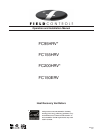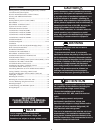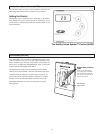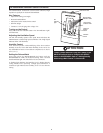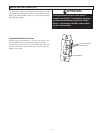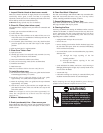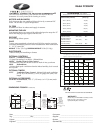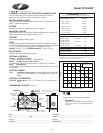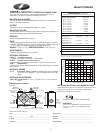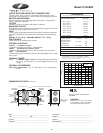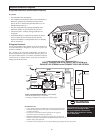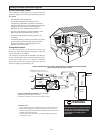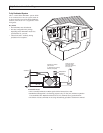
3
Thank you for purchasing a Field Control Heat/Energy Recovery
Ventilator (HRV/ERV). The HRV/ERV provides fresh air to your
home while recovering energy from the air it exhausts.
There are numerous benefits to a properly installed, operated, and
maintained HRV/ERV:
• Exhausts the stale, contaminated air, found in today’s tight
buildings.
• Recovers the majority of the energy contained in the exhausted
stale air.
• Uses the recovered energy to preheat or precool the fresh outdoor
air introduced into the house
• Distributes the fresh air throughout your home.
Getting to Know your Heat and Energy Recovery Ventilator (FC Series)
Optional Controls are available to adjust the amount of ventilation
in your home:
• The Healthy Home System™ Control (HHSC) will automatically
deliver fresh air to your home.
• The Dehumidistat Control (DHI) can be used in conjunction with
the HHSC to provide additional ventilation for high indoor
humidity levels.
• The Dehumidistat Ventilation Control (DHVC) is a manual
control which features ON/OFF, High speed, Low Speed, and an
electronic dehumdistat.
*Refer to the individual control pages of this manual for more
information about these controls.
Ventilation and Control Options*
High indoor humidity levels, during the heating season, have
become a problem in many well insulated, tight homes. Excessive
condensation on the windows is a visual sign of high indoor
humidity levels. High indoor humidity levels can result in mold and
mildew and the eventual degradation of the building structure itself.
Your HRV/ERV reduces indoor humidity levels when the
outdoor air is drier than the indoor air. These conditions usually
occur during the heating season when outdoor temperatures are less
than 15°C (59°F). During the heating season, the operation of the
HRV/ERV may reduce indoor humidity levels sufficiently to
eliminate the need for further dehumidification.
If your home requires further dehumidification, use the
dehumidistat feature located on any optional main control (refer to
the Operation and Installation Manual for Optional Control
information). This feature aggressively addresses high indoor
humidity levels by initiating high speed ventilation when the indoor
humidity levels rise above the adjustable set point on the control.
Refer to the main control instructions located in the Operation and
Installation Manual for instructions on how to set the dehumidistat.
The dehumidistat function on the main control should be set to OFF
for all seasons except the heating season, because a dehumidifying
effect occurs only when the outdoor air is dryer than the indoor air.
Set the RH level to 80 to turn the dehumidistat OFF. (Refer to the
control instructions for information on how to set the
Dehumidistat).
DEHUMIDISTAT DISABLE - automatically disables the
dehumidistat function on the main control when outdoor
temperatures exceed 15°C (59°F) for a full 24 hour period. All other
HRV features and functions operate normally while the
dehumidistat function is disabled.
DEHUMIDISTAT RE-ENABLE - automatically re-enables the
dehumidistat function if either the outdoor temperature drops below
15°C (59°F) for a full 24 hour period or if the HRV is reset
(unplugged for 30 seconds).
How the Dehumidistat Works (Colder Climates)
DEFROST MODE - To ensure reliable operation during cold
weather, the HRV automatically cycles through its defrost mode
when the outdoor temperatures drop below freezing.
HRV/ERV - a Heat Recovery Ventilator (HRV/ERV) is designed
to provide fresh air into a building while exhausting an equal
amount of stale air. During the winter months, heat recovered from
the stale air, before it is exhausted to the outdoors, warms the
incoming cold fresh air. During the summer months, when the
indoor space is air conditioned, the HRV/ERV helps to cool the
incoming fresh air with the cool exhausted stale air.
SELF-TEST - Each time the HRV/ERV is powered/energized, the
self-test function automatically initiates. The HRV/ERV cycles
through the available speeds and tests the damper motor operation.
The HRV/ERV defaults back to the previous operational mode and
speed selection after the self-test (approximately 60 seconds in
duration).
STANDBY - The HRV/ERV is powered/energized and waiting for
ventilation to be initiated by an external control.
TIMERS - These optional controls may be installed at specific
exhaust locations (bathrooms etc.) to initiate high speed ventilation.
Heat Recovery Ventilators (HRV) carry a Lifetime Warranty on the
heat recovery core and a 5 (five) year replacement parts warranty.
Energy Recovery Ventilators (ERV) carry a 5 (five) year warranty
on the energy recovery core and a 5 (five) year replacement parts
warranty.
Glossary and Additional Information
Warranty



